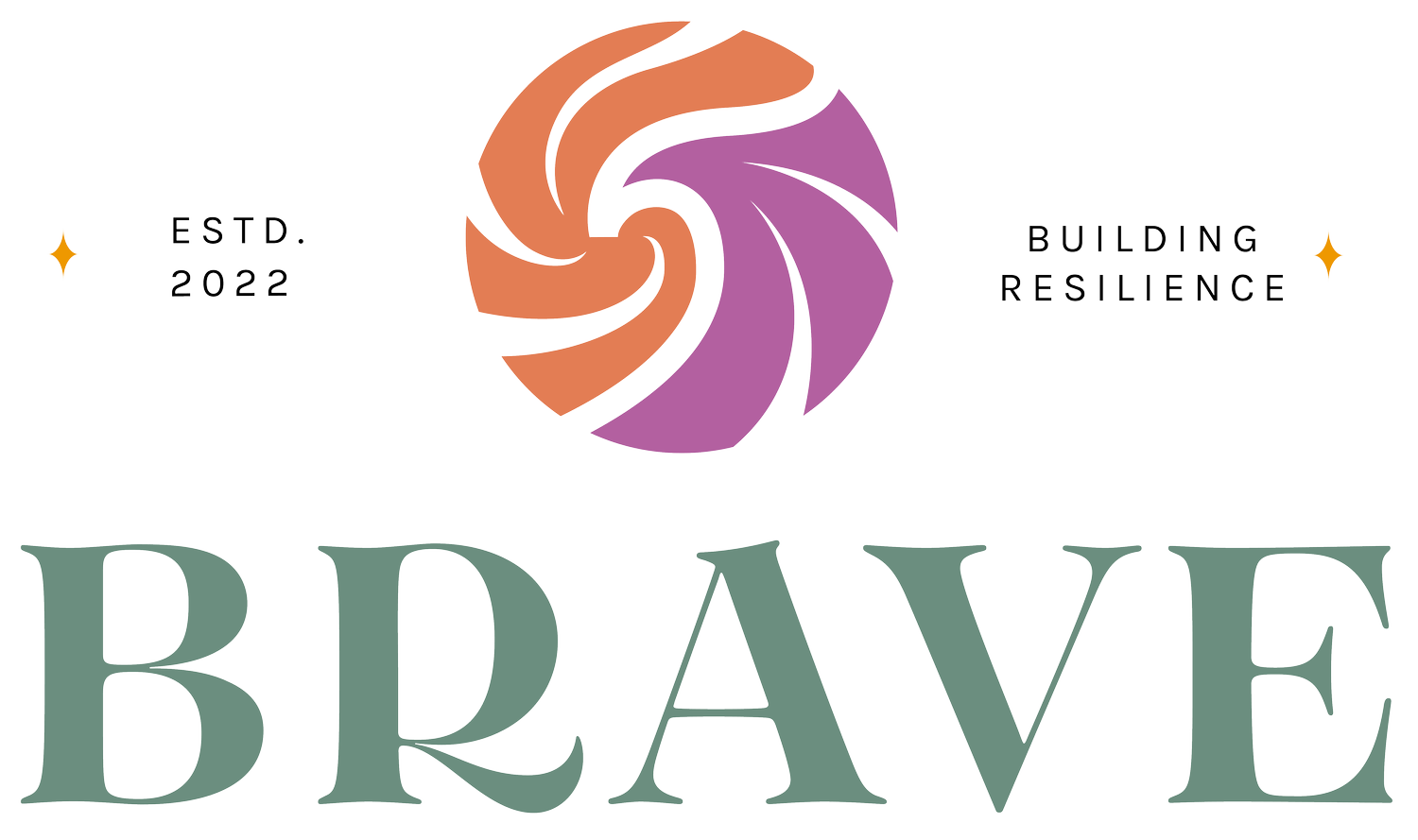Managing Vicarious Trauma when the World is on Fire
In our last blog post, we talked about the intersection of racial trauma and vicarious trauma for trauma therapists. Understanding the impact of these experiences is essential, but it gets even more complicated when we consider the impact of global events.
As the world feels increasingly chaotic, we, as trauma therapists, face heightened challenges, both personally and professionally.
This month’s content call in The BRAVE Trauma Therapist Collective was inspired by the courage of one of our members when, during consultation, she bravely shared how deeply she's been feeling for people affected by global traumas. At the same time, she talked about feeling so stuck and frozen when inundated with current events!
Her honesty spoke straight to our hearts, highlighting the need to address how global events amplify our experiences of vicarious trauma and to find ways to navigate this double whammy of trauma exposures.
The Double Burden of Global Events and Vicarious Trauma
As trauma therapists, we experience vicarious trauma as a normal part of our jobs. Global events—anything from natural disasters to political unrest and beyond—then add an extra layer of stress to our already heavy work.
As we serve our clients in their work to heal from trauma and PTSD, we are also processing our own reactions to these global crises. This results in a "double dose" of trauma exposure, affecting us on both professional and personal levels.
When this happened during the COVID-19 Pandemic, there was no hiding from the fact that we were all going through a collective trauma.
Now though, as things get back to “normal” (whatever the hell that means), we are going back to holding space for our clients while trying to care for our own, invisible, needs.
I’m not saying our clients need to know about all our struggles as trauma therapists, but when we were all going through COVID together, it normalized the stress and trauma in ways that were new, that allowed us to be seen and heard.
I know I’m not alone in saying that was a silver lining of that whole experience.
Fast forward to now…During our recent Content Call in The BRAVE Trauma Therapist Collective, having a protected space to share together about how global events are impacting us as humans first and also as trauma therapists was an important step in healing for many of us.
One of our members even shared that earlier that morning she was expressing a need to talk about the double whammy of vicarious trauma and current events, and that joining the Content Call helped her know she was not alone.
Knowing we’re not alone in this stuff can truly make all the difference.
And, at the same time, we so often feel silenced and stuck in how to understand the impact when the world is on fire and our work doesn't stop—instead, becoming even more crucial.
So often, the important first step is call a thing a thing and acknowledge that we’re being affected by vicarious trauma and global events as trauma therapists. By naming this "double dose" of exposure, we can start to understand our reactions and take steps to respond to our needs right now at this moment.
Reflecting on Overlaps
To take these first steps, members of BRAVE courageously worked together, starting with a reflective exercise to help us notice the emotional and physical responses to our work as trauma therapists and the ongoing global events.
We didn’t keep these insights compartmentalized though - we also had to notice the overlaps that remind us we’re humans first!
Some of the feedback from BRAVE members was that creating space for this process helped them realize that the stress and trauma from global events often mirrored the vicarious trauma they absorbed from their clients.
These aha moments underscored an important point: we can't separate our professional selves from our personal lives.
The stress we encounter in one sphere inevitably impacts the other. Recognizing these overlaps is the first step in addressing the compounded effects of vicarious trauma and global stressors.
Emotion Mind and Wise Mind
Quick refresher on the DBT skill of Wise Mind, or the integration of Emotion Mind and Logic Mind that allows us to be with our emotions while also considering more concrete rules and logic.
When we can access our Wise Mind as trauma therapists, we are able to have more grounded and thoughtful actions.
The reflective exercise on our BRAVE Content Call was designed to help our members get into their emotion mind - to really notice the combined impact of vicarious trauma and global events. My job as the facilitator was to honor this experience while guiding us back towards Logic Mind through guided questions. This process found us more firmly in Wise Mind, where we could create personalized action steps.
Of course, we don’t often have shared communal experiences like this, so as you are navigating these trauma exposures in your regular daily life, remember some of our go to tips for grounding and centering to help you anytime you need to find your wise mind:
Mindful Breathing: Take slow, deep breaths, focusing on the sensation of the breath entering and leaving your body. This can help calm your nervous system and bring you back to the present moment.
Body Scanning: Perform a mental scan of your body from head to toe, noticing any areas of tension or discomfort. This can increase body awareness and help release physical stress.
Grounding Techniques: Engage your senses by noticing the details of your environment. Focus on the sounds, smells, textures, and sights around you to anchor yourself in the here and now.
Reflective Journaling: Write down your thoughts and feelings about the stressors you're facing. This can help externalize your emotions and provide clarity.
Peer Support: Reach out to colleagues or join a support group like The BRAVE Trauma Therapist Collective. Sharing your experiences and hearing others' perspectives can provide validation and new insights.
By regularly practicing these techniques, we can cultivate the ability to transition from Emotion Mind to Wise Mind, even amidst the chaos of global events and the demands of our work. This balanced state of mind allows us to respond to challenges with greater resilience and wisdom.
Informed Decision-Making and Ethical Anchoring
One of the key takeaways from our content call was the importance of making informed decisions about what we share, how we share it, and with whom we share it. This process becomes even more critical in the context of global events and the compounded stress they bring to our work as trauma therapists.
During our call, we emphasized several steps to help guide this decision-making process:
Naming Your Priorities: Identify the most important aspects of the current events or trauma-related knowledge that you want to communicate.
Anchoring In: Consider how your communication aligns with your ethics, values, and professional responsibilities.
Clear Communication: Once you know what you want to share, think about how to express your thoughts clearly and effectively.
Safe Communication: Acknowledge that as a licensed mental health provider, you have specific ethical and legal obligations. Make sure your communication protects your license and adheres to professional standards.
By anchoring our decisions in our core values and professional ethics, and by leaning on our community for support, we can navigate the challenges of sharing information amidst global events. This approach helps us stay true to ourselves and our professional responsibilities, even when the world feels overwhelming.
And while these steps are helpful, having a supportive community to guide us through these decisions really made all the difference. When you walk through questions like these with trusted colleagues, you are able to receive the support and validation you need to access your Wise Mind.
Choosing the Right Platforms and Audiences
For trauma therapists who want to share their message more broadly, say on social media, choosing the right platforms and audiences is super important when discussing sensitive topics like trauma and global events.
These choices can help make sure that our message is both impactful and received by those who need it most.
Choosing the right platforms and audiences also means understanding the unique features and limitations of each medium. For instance, social media platforms can be great for reaching a broad audience quickly but may not be suitable for detailed or sensitive discussions. Conversely, professional forums or webinars can provide a more controlled environment for in-depth conversations but may have a more limited reach.
By carefully selecting where and how we share our messages, we can ensure that our communication is effective, respectful, and aligned with our professional values. This thoughtful approach helps us make the most of our efforts and ensures that our messages are heard by those who need them most.
Ethical Considerations and Licensing Requirements
Deciding what, where, and with whom to share information is a complex process, especially in the realm of trauma therapy.
It’s not black and white until it is!
That is, until we come back to the importance of our ethical guidelines and licensing requirements. This step is crucial to ensure that our communications uphold the highest standards of our profession and, let’s be honest, protects the license you worked so hard to earn.
Once you know what you want to share and who your audience is, make sure you anchor into the rules and guidelines of your professional ethics and licensing requirements.
Because this is going to vary slightly (or a lot!) depending on what kind of trauma therapist you are (e.g. your credentials), I have pulled together a list of Ethics Codes and Licensing Requirements for the most common license types:
Make sure you review these regularly so you know you’re following your professional code of ethics and to licensing requirements. This makes sure to protect our professional integrity, ensure that our messages are both responsible and effective, and protects your license!
Next Steps
Navigating the intersection of racial trauma, vicarious trauma, and the added stress of global events is no small feat for trauma therapists. It’s crucial to recognize the double whammy of these trauma exposures, to take proactive steps to manage our well-being, and to have clear and Wise Minded ways to choose how and what to share about this stuff.
Having a supportive community and trusted colleagues is essential in managing these challenges. Without other trauma therapists to talk to about the impact of vicarious trauma and global crises, we don’t get the support, validation, and feedback we deserve.
Where Can You Find this?
If you’ve been looking for a supportive space to work on this stuff, our upcoming Racial Trauma and Vicarious Trauma Quarterly Spaceholder Meeting might be a great place to start.
Our Racial Trauma and Vicarious Trauma Space Holder Meetings with Tawanna Woolfolk and Jenny Hughes are FREE (CEUs available for purchase), and provide a dedicated space for deep, meaningful conversations and collective support.
When you join us, you’ll get to connect with fellow trauma therapists, share your experiences, and gain valuable tools to navigate the complexities of our work and the world around us.
Remember, you are not alone in this journey.
Together, we can support each other through the toughest times and continue to provide the best care for our clients. Use the strategies and insights shared here to help manage your own well-being and to stay true to your professional values.





